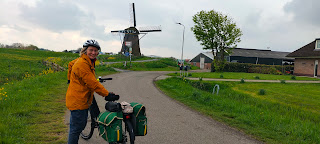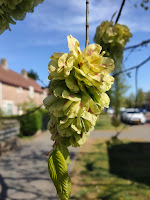Each day of riding is different.
This sounds like an obvious thing to say but unless you are mentally prepared for the Dutch infrastructure it keeps throwing surprises. We spend a whole day getting from A to B on a pre-planned route which criss-crosses roads, railways and canals and at each change of direction we encounter something different. A fietspad (cycle path) may be a wide, two-way path on just one side of a road or there may be separate one-way paths on either side. Often the paths move away from roads and are exclusively for cyclists. These may be wide or narrow but still cater for cyclists going both directions and sometimes have trees growing alongside whose roots have lifted the tarmac enough for caution to be needed. Then sometimes there is a full width cycle-only path which bends around a windmill.The narrow streets in a town or village are usually paved with klinkers (bricks or small pavers), the presence of which signifies speed restrictions (for cars). Where there are shops the cyclists can simply pull over to one side and prop the bike on its stand wherever is convenient (on what we would call the pavement). I think this is called 'parking'.Flowers are important things here too and a floral display might pop up anywhere, without any explanation that we can understand. Grand mansions may also pop into view without warning alongside a quiet and deserted woodland path.Our first encounter with rain on our journey, a steady light drizzle, was enough to justify donning full waterproofs for the first time.
We are not long into our holiday but thankfully the wind is light and by midday the rain had stopped, enabling us to sit outside and eat the frites (chips) we had ordered to go with our lunchtime coffee. Several days later, however, we got proper rain. We had spent a relaxing morning in Delft before setting off on a path beside a wide commercial waterway and looking ahead we could see what was coming our way. The rain pelted down and by the time we made it to Rotterdam the water was filling the streets faster then the drains could take it away. This was the first real test of our equipment, the panniers, the bikes, our clothing, and our resilience in the face of torrential rain. By the time we arrived at our pre-booked hostel we'd had enough and we were glad to be allowed to drip upon the floor inside. Over the course of our two day stay our wet things soon dried off.One thing that has to survive in these conditions is the phone I am using for navigation. A waterproof bag on my crossbar enables me to keep the screen in view and routing instructions are transmitted into my ears via bluetooth. The system is not perfect but it did take us right into the centre of Rotterdam despite road closures, rush hour traffic and the enormous puddles giving us probably the most severe test we could have wished for.
The city is very busy, full of art works, and not a place for the faint hearted. But the nice thing about the whole infrastructure here is that where cars, bikes and pedestrians meet the signage at the crossing places always provides a clear set of rules so that the priority is clear... and usually it is the bikes that can cross first.Bikes fill the cities... and everywhere else.Any time someone leaves (parks) their bike it is immediately secured by a clever sliding lock fixed to the frame just in front of the back wheel. We call these 'Dutch bike locks' for the simple reason that every bike here has one. The problem for us was that they are not fitted to British bikes, which makes us feel our bikes are quite vulnerable here, an easy steal for a thief. On our journey through Holland we tried several bike shops but we were told they could not be fitted as our bikes are not made with the appropriate screw hole to fasten the lock to the frame. It was not until we arrived in Delft that we found a clever bike shop owner who knew better and from that moment on we feel much safer when parking our bikes anywhere on the street. The fact that they survived two nights left by the roadside on a busy street in Rotterdam stand as a testament to the deterrent value of these locks. We love them.
















.webp)



